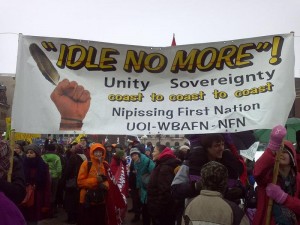11.12 Idle No More
Mary-Ellen Kelm, Department of History, Simon Fraser University

On June 11, 2008, Prime Minister Stephen Harper rose in Canada’s House of Commons to give an official apology for residential schooling. He called the treatment of Aboriginal children in the schools “a sad chapter in our history,” for which “the Government of Canada sincerely apologizes.”[1] Mr. Harper and the other party leaders expressed palpable remorse for the past injustices of Canadian policy, and leaders representing First Nations, Métis, Inuit peoples, women, and urban Aboriginal people gravely responded to the apology from the floor of the House.
For many Canadians, this promised to be a turning point in our relations with Aboriginal peoples. Until the 1990s when stories of abuse in the schools hit the media and the courts, most Canadians had never heard of the schools. Now the Prime Minister of Canada was admitting that a government policy had been wrong and that the attitudes that inspired the policy have “no place in Canada.” More importantly, he promised a new relationship between Aboriginal peoples and Canadians, one of shared history, renewed understanding, and new respect for all cultures, traditions, and communities.[2] Two processes were meant to bring this new relationship about. First there was compensation for those who attended the residential schools. Second, the Truth and Reconciliation Commission (TRC) was tasked with documenting the full history of the schools. Restorative justice scholars gave the Harper apology high marks.[3]
However, the apology was not a turning point. Its major failing was that it situated all the wrongs of government policy in the past. It did not commit the Canadian Government in any concrete way to changing its actions towards First Nations, Inuit, and Métis peoples in the present. This was a significant mistake because a changed relationship with Canada was what Aboriginal people wanted.[4]
By 2008, Aboriginal people in Canada had already begun to shift the conversation between themselves and Canadians in really fundamental ways. In the 20th century, Aboriginal people demanded government recognition of their rights and title to the land. As a new generation of Aboriginal leaders arose, they increasingly sought resurgence — of their own cultures and communities — rather than recognition. They wanted a new relationship with Canada, the kind of relationship of sharing and mutual respect that their ancestors had expected when they signed treaties.

The trouble was that Aboriginal people have not shared equally in Canadian wealth. In some parts of Canada, Aboriginal people have poverty rates that are three times those of other Canadians.[5] Less money is spent on reserve schools and Aboriginal children are ten times more likely to end up in foster care.[6] So while Mr. Harper was apologizing for the damage done to Aboriginal children and families by residential schools, the legacies of residential schooling continued unabated.[7]
The Cree community of Attawapiskat has become emblematic of Canada’s dysfunctional relationship with Aboriginal people. An isolated community on the shores of James Bay, Attawapiskat made the news repeatedly in the early 2000s. Its only school was condemned as a health hazard, and student Shannen Koostachin took her demands for a new school to Ottawa in 2007. Four years later, Chief Theresa Spence (b. 1963) declared a state of emergency over inadequate housing. What made the situation worse was that the multinational corporation DeBeers was just 80 km away making a steady profit mining diamonds from Cree lands. The agreement DeBeers signed with Attawapiskat to share the mine’s benefits did not include infrastructure, such as schools and houses, because that was, they argued, the responsibility of the Canadian government.[8] On December 11, 2012, Spence announced that she would go on a hunger strike to protest unfulfilled treaties. [9]
When Spence announced her hunger strike, she joined an already growing wave of protest and resurgence among Aboriginal people. The protest centred on government Bill C-45, a 457-page omnibus bill that loosened legal restrictions inhibiting investment in Canadian resources. The changes that C-45 introduced to the Indian Act, for example, made it easier to lease or surrender reserve land by removing the democratic requirement for a community-wide vote. First Nations were not consulted on any of these changes. Within a month of C-45’s first reading, on 10 November 2012, four Aboriginal women in Saskatoon — Sylvia McAdam, Nina Wilson, Jessica Gordon, and Sheelah McLean — conducted a teach-in on the bill, which they publicized under the name Idle No More.[10]
For the next six months, Idle No More exemplified Aboriginal resurgence. Social media was a major force in Idle No More: by May 2013, there had been over 1.2 million Twitter mentions of the #Idlenomore hashtag. The social media profile of Idle No More underscores an important feature of the movement: it was diverse and dispersed in its power and its leadership — not linked to any mainstream Aboriginal organization. Idle No More acknowledged the importance of women in Aboriginal communities, and they often took the stage at events. To honour her leadership, the movement rallied behind Chief Spence in her hunger strike.
To emphasize the social media component is, however, to miss the incredible live experience of the movement. Hundreds attended teach-ins across the country to learn more about bill C-45, and how it violated treaty rights. Thousands marched on Parliament Hill on January 10, 2013 and participated in coordinated days of action across the country.
The Harper apology in 2008 and the subsequent findings of the TRC, released in 2015, have given Canadians ample reason to reflect on their failed relationship with Aboriginal people. Yet Aboriginal people ask not that Canadians focus on the past, but on the present and the future. TRC Chair, Chief Justice Murray Sinclair, has said that Canada will fail to uphold the spirit of the 2008 apology unless it commits to involving Aboriginal people in decisions about their lands and resources.[11] This too was Idle No More’s demand as the movement expressed renewed pride among Aboriginal peoples for their grassroots leadership and traditional methods of peaceful social change.
Key Points
- The intent of Harper’s 2008 apology was to bring an end to the saga of the residential schools, but it provided little in the way of a plan for moving forward.
- Compensation and a Royal Commission on Truth and Reconciliation followed.
- Aboriginal peoples sought two things in particular: a resurgence, rebuilding of their cultures and communities, along with an equitable share of Canadian prosperity. Substandard housing conditions, water supplies, and school facilities on reserves became a focus.
- Changes to the Indian Act introduced in 2012 promised to further weaken Aboriginal control over reserve and traditional lands — a prospect that spurred the Idle No More movement.
- One result of these developments has been a shift in discourse among Aboriginal peoples and among Canadians generally.
Attributions
Figure 11.20
Idle No More 2013 Ottawa 1 by Michelle Caron (Moxy) is used under a CC-BY-SA-3.0 license.
Figure 11.21
Jericho Diamond Mine pit Nunavut Canada by Tomchurchill is in the public domain.
- Stephen Harper, “Statement of Apology to Former Students of Indian Residential Schools,” House of Commons, Ottawa, June, 11, 2008, accessed April 27, 2016, https://www.aadnc-aandc.gc.ca/eng/1100100015644/1100100015649 ↵
- Ibid. ↵
- Sheryl Lightfoot, “Settler-State Apologies to Indigenous Peoples: A Normative Framework and Comparative Assessment,” Journal of the Native American and Indigenous Studies Association 2, no. 1 (2015): 33. ↵
- Beverley Jacobs, “Response to Canada’s Apology to Residential School Survivors,” Canadian Woman Studies 26, no. 3/4 (2008): 223; Sheryl Lightfoot, “Settler-State Apologies to Indigenous Peoples: A Normative Framework and Comparative Assessment,” Journal of the Native American and Indigenous Studies Association 2, no. 1 (2015): 33. ↵
- Shauna MacKinnon, “The Harper ‘Apology’: Residential Schools and Bill C-10” (Winnipeg: Canadian Centre for Policy Alternatives, Manitoba Office, January 24, 2012); Aboriginal Children in Care Working Group, Aboriginal Children in Care: Report to Canada’s Premiers (Ottawa: Council of the Federation Secretariat, 2015): 45. July 2015: 45. ↵
- Don Drummond and Ellen Rosenbluth, “The Debate on First Nations Education Funding: Mind the Gap,” Working Paper, Queen’s University Policy Studies (Kingston: Queen’s University, December 2013); Aboriginal Children in Care Working Group, “Aboriginal Children in Care,” 7. ↵
- Aboriginal Children in Care Working Group, Aboriginal Children in Care, 6. ↵
- Kelly Crichton, Producer, 8th Fire: Canada, Aboriginal Peoples and the Way Forward, Documentary Series, Canadian Broadcasting Corporation, 2012, accessed April 27, 2016, http://www.cbc.ca/player/Radio/More+Shows/8th+Fire+-+CBC+Series/Doc+Zone+video/Promos/ID/2172311969/. ↵
- The Kino-nda-niimi Collective, The Winter We Danced: Voices from the Past, the Future, and the Idle No More Movement (Winnipeg, MB: ARP Books, 2014), 391. ↵
- Ibid., 390. ↵
- APTN National News, “PM Harper Has Failed to Live up to Promise of 2008 Residential School Apology: TRC,” June, 2, 2015, accessed April 27, 2016, http://aptn.ca/news/2015/06/02/pm-harper-failed-live-promise-2008-residential-school-apology-trc/. ↵

